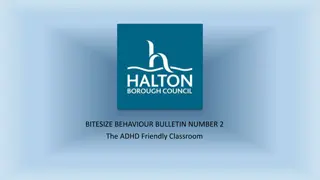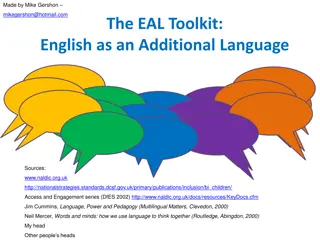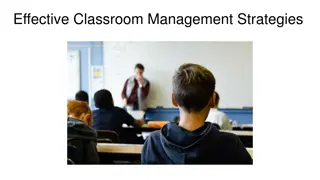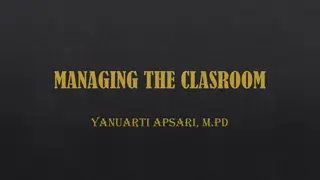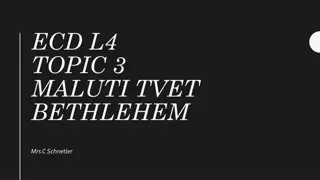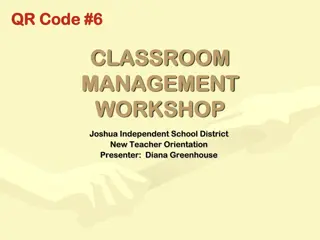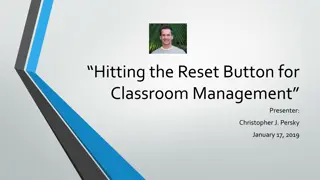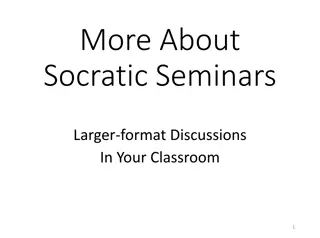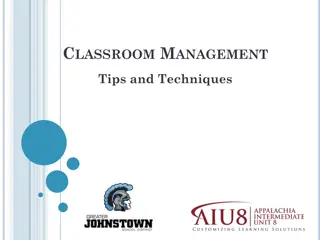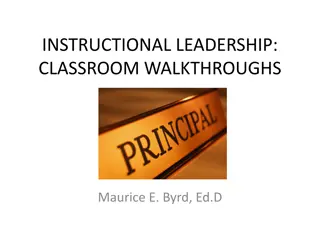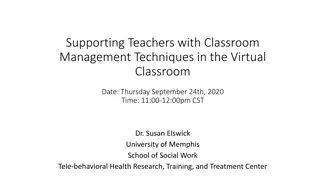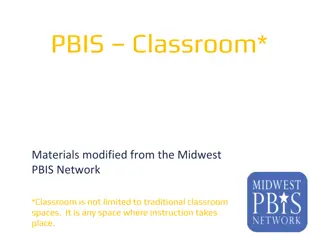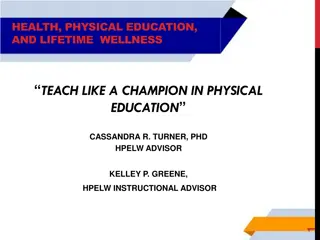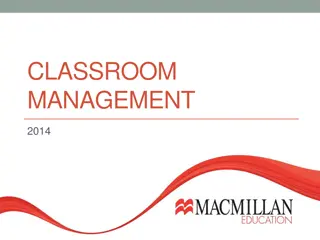Effective Strategies for Classroom Management
Understanding challenging behaviors, establishing codes of conduct, defining behavioral expectations, and outlining rights and responsibilities in the classroom are crucial components of effective classroom management. By addressing these aspects, educators can create a positive and structured learning environment that promotes student engagement and success.
- Classroom management
- Challenging behavior
- Code of conduct
- Behavioral expectations
- Student responsibilities
Download Presentation

Please find below an Image/Link to download the presentation.
The content on the website is provided AS IS for your information and personal use only. It may not be sold, licensed, or shared on other websites without obtaining consent from the author. Download presentation by click this link. If you encounter any issues during the download, it is possible that the publisher has removed the file from their server.
E N D
Presentation Transcript
Classroom management Classroom management Elizabeth Karakehagias Educational Consultancy Group educongr@hotmail.com 12/04/2012 1
What is challenging behaviour? Constant calling out Interrupting Distracting others Distracting the teacher 2
Code of conduct Does the school have a policy or a code of conduct that includes procedures? Whose responsibility is it to establish and monitor the code of conduct? Are there common classroom rules? 3
Guidelines for Defining Behavioural Expectations Identify Classroom rules and expectations Establish School Rules (Rights and Responsibilities?) Rules should be broad enough to cover all potential problem behaviours Make rules positive Post them in your classroom 4
Why 3-5 Rights and Responsibilities? Easier to learn and remember than a long list of specific behavioural expectations Posting them creates a visual cue for students and staff to remind them of the rules State rules positively What TO DO!!! as opposed to what Not to do 5
Rights and Responsibilities in the Classroom (1) In this classroom, students and the teacher have the right to do as much work as possible. Therefore, their Personal responsibilities include: o Students should bring all their equipment to class o Students should listen when others are speaking o Students should be on time o Students should attempt all work 6
Rights and Responsibilities in the Classroom (2) Their Communal responsibilities include: o Students should encourage others to bring all their equipment to class o Students should encourage others to listen when others are speaking o Students should encourage others to be on time o Students should encourage others to attempt all work 7
Rights and Responsibilities in the Classroom (3) In this classroom, students and the teacher have the right to feel comfortable and safe. Therefore, their Personal responsibilities include: o Students should pass all objects hand to hand o Students should speak politely o Students should keep their hands to themselves 8
Rights and Responsibilities in the Classroom (4) Their Communal responsibilities include: o Students should encourage others to pass all objects hand to hand o Students should encourage others to speak politely o Students should encourage others to keep their hands to themselves 9
Be Proactive! & less reactive We need to explicitly teach expected and desired behaviour, rather than take the risk, or expect, that students should know , or they will figure it out on their own Our tendency when students don t follow behavioural expectations is to punish students rather than teach students Would we punish a student for not reading a word correctly? 10
Plan Ahead (before school year & each day) Set habits early rather than waiting to change students habits later Before we can teach, reinforce, and enforce anything in our classrooms we must clearly define: 1. fair behavioural expectations 2. effective behavioural routines 11
Strategies to avoid disruption (1) Keep the lesson flowing: Know exactly what you are going to do and have all necessary resources ready At the beginning of the lesson tell the students the activities they are going to do Set up an accepted and fully understood pattern for distribution of materials, roll- marking, going to the toilet
Keep the lesson flowing: (2) Let students know when an activity is about to be changed so they prepare to finish what they are doing and mentally get ready for the next activity Attend to the needs of the majority and have them engaged before dealing with individuals Give all instructions clearly and concisely
Some important donts. Don t spend more time on any activity than necessary Don t interrupt a discussion or activity to jump from one thing to a different one Don t allow yourself to be sidetracked into answering irrelevant questions
Strategies to avoid disruption (2) Keeping students interested. Vary the volume, speed and tone of your voice Be enthusiastic about what you are teaching Vary the way you teach e.g. use a variety of procedures such as assignments, debates, excursions, group work Move around the room Ensure that the lesson content is challenging but achievable and whenever possible relevant
Strategies to avoid disruption (3) Keeping students focused: When asking a question, take a number of answers before saying whether they are correct After asking a student to answer, allow a few seconds for them to answer Collect and correct all homework
Strategies to avoid disruption (4) Making students feel monitored. Try to position yourself so that by lifting your eyes you can see all or most of the class Try to make eye contact with as many students as possible during the lesson When talking to one student do not become oblivious to the rest of the class
General tips for behaviour management (1) Label the behaviour not the child Children aren t born with behaviour problems, they learn them All behaviour has a purpose What you see is what you can change Nip behaviour problems in the bud School needs to be seen as a good place
General tips for behaviour management (2) Students and teachers both have rights and responsibilities to ensure a good learning environment Consider the curriculum tasks may be too easy or too difficult or just not motivating Changes in the seating arrangements or time for certain activities Children need freedom to move within clearly-defined limits
General tips for behaviour management (3) Start on one aspect of behaviour first Always be consistent and clam in your approach Catch the child being good rather than focusing on the negative Students need to feel they belong. Devise classroom rules (Rights and Responsibilities) together
General tips for behaviour management (4) All students want to feel valued and respected and to be part of the group. A positive self-image is vital. It is important to communicate effectively with students. Make sure you listen to them. Students need to know the consequences Modelling and imitation are valuable techniques for students to acquire appropriate behaviour.
References The developmental management approach to classroom behaviour. Ramon Lewis





